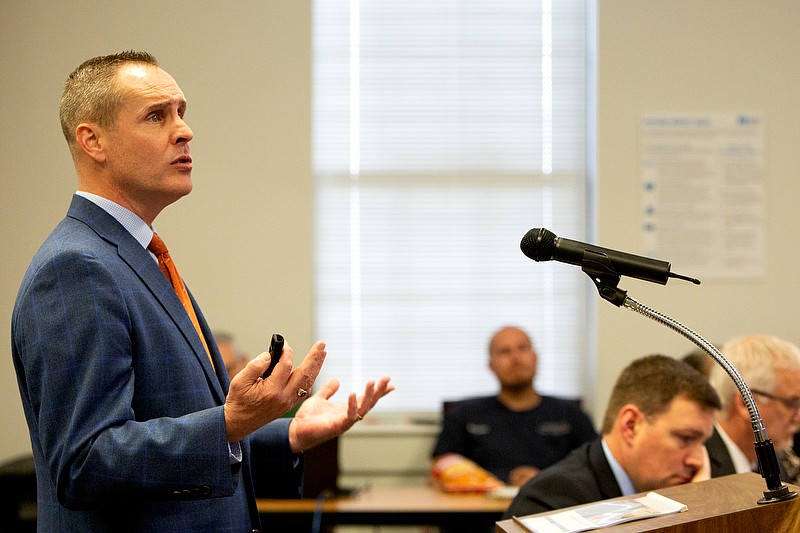The loud clunk you just heard was the Hamilton County Schools facilities master plan landing in the lap of the community.
What the community chooses to do with it will determine in what direction local public education will move over the next quarter century.
Since the Chattanooga City and Hamilton County schools merged in 1997, community members - sometimes with the help of education officials - have made several critical decisions about schools here.
They wanted more but smaller schools than is average for a county of our size, and they wanted smaller class sizes. Twenty-three years after the merger, that has resulted in the county employing 500 more teachers than the state's Basic Education Plan formula calls for in a school district of our size (and those extra teachers are thus not funded by the state), and it has resulted in a district that will require $1.36 billion to operate over the next 10 years.
"It's a non-sustainable situation," said Mike Raisor, senior vice president of MGT's Education Solutions Group, which submitted the new facilities plan after more than a year of work. "There has to be action taken."
What has been recommended is a three-phase, $891 million plan that includes 11 new buildings, 27 renovated buildings, six buildings that will require increased capacity, four new locations/sites and nine closed sites.
(MORE: Final Hamilton County school facilities report recommends three-part, $891 million plan)
However, the community can speak with its voices, its wallets and its votes and tell school board members to dump the plan in the garbage. They can choose for the district to continue as it is, occupying inefficient, underequipped and under (or over) capacity schools, and building new schools only when absolutely necessary.
We hope they won't do that.
Currently the district lives with one or two property tax increases every decade or so. School maintenance needs continue to pile up, educational choices for students remain stifled, and the savings that might have been realized from a more efficiently operated district are not be plowed back into the classroom.
Hamilton County, according to Brent Goldberg, the school district's chief business officer, is the only county in the state with more than 20,000 students that does not have alternatives to generating revenue for schools besides property tax (and a little from sales tax). Other counties, for example, have implemented motor vehicle wheel taxes, impact fees or something else to support public schools.
In many states, school boards have taxing authority. In Tennessee, only 14 special school districts, each established by private acts of the legislature, have such authority.
In Georgia, a special-purpose local-option sales tax (SPLOST) is often used for funding capital projects such as school construction.
"It's a community issue," said Goldberg. What is done, or not done, based on the facilities master plan, is "what the community wants to do."
We could spend this entire page discussing each individual recommendation by MGT, which was paid more than $500,000 to come up with the plan, but the recommendations will be freely debated in community meetings that now will likely be called. In the end, some things may be changed before the first dollar is committed, if in fact any dollar is committed.
What we especially like in the plan is more seats at the district's highest performing magnet schools, where school officials say there is a waiting list of 800 to 1,000 students. We have advocated for additional seats in these schools for years, so seeing that goal fulfilled in the future would be gratifying.
(MORE: What does the final Hamilton County facilities report recommend for your school?)
But what does the community want?
Last year, Hamilton County commissioners voted down a 34-cent property tax increase for schools in part because they knew the facilities plan was on the horizon. Now it's here, its recommendations are final, and no one will have MGT to blame any more about what is or is not in the plan. The company completed what the school board asked it to do, considered public feedback and then submitted a revised plan.
A district budget for the 2020-2021 school year and beyond is already in the works. It will not include anything in the facilities plan except what already had been on the drawing board before the consulting firm ever was hired. No students will attend different schools than they planned on in the fall of 2020 except what already was ongoing.
But beyond that?
Nobody wants to pay more taxes, but a plan to transform Hamilton County Schools will require more money and should command a robust discussion about any and all options.
The community and most of its elected leadership for the last 23 years decided that inefficient, undercapacity and underequipped were OK as long as schools and class sizes were small. Now they - we - have decisions to make. Community members can embrace change and a better learning environment for all public school students (and agree on how to pay for it), or they can say, "No, we've got ours. We're good."
Which will it be?
